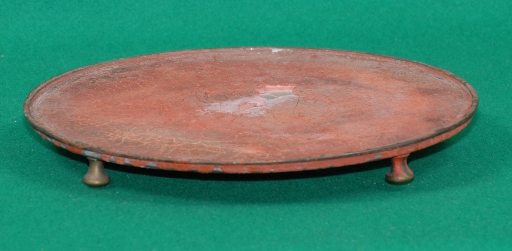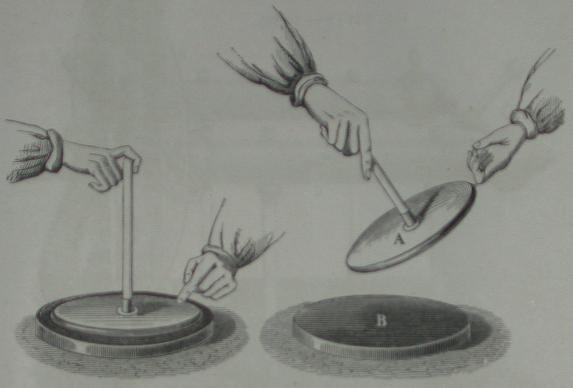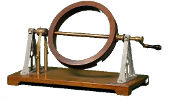» Electrophorus Insulating Plate (0021)
Immagini


DESCRIPTION
Exhibit 21 is the electrophorus invented by Alexander Volta, an early electrostatic generator based on induction. It consisted of two parts: a metal disk with an insulated handle and the base, a flat metal disk with upturned edges that could be thus covered with a resinous mixture a few millimeters thick. The mixture suggested by Volta was made of three parts by weight of turpentine of Strasbourg, two of normal turpentine (pine resin) and one of wax. After being boiled for some hours, mercuric sulfide was added giving it a characteristic red color. This paste was then spread on the base and allowed to harden.In use, the base was first charged negatively by rubbing with the fur of a cat or a rabbit or with the leather rubbing plate (exhibit 20). Then the shield was placed on the base and by induction positive charge appeared next to the base and negative charge on the opposite face. By touching the outer face, the negative charge disappeared to ground. Now the shield could be lifted from the base and carry with it a positive charge that could draw sparks. In this procedure the base did not lose its charge because it was an insulator and the shield could be recharged immediately by placing it on the base.
The figure is reproduced from the treatise of Ganot
BIBLIOGRAPHY
- [1] A. Ganot, "Traité Élémentaire de physique", Paris, 1868
Dati Catalografici
| Data di costruzione: | --- |
|---|---|
| Data di carico: | sconociuta |
| Nr. Inventario: | Ignoto (Ignoto) |
| Costruttore: | Costruttore sconosciuto |
| Materiale: | resina fenolica, metallo |
| Dimensioni: | Diametro: 23 cm |
| Conservazione: | cattivo (In alcuni punti la resina si è staccata) |
